Apartment Prepping – Where and How to Store Water
Whenever a panic hits, ever notice that one of the first things people start to hoard is water? Even if the power is on and the water is flowing, they start buying bottled water as if they will never see any again in their lives. This is really stupid, wasteful, bad for the planet and unnecessary. People that were a month ago complaining about straws killing turtles are now buying cheaply produced, one-use plastic bottles that are full of chemicals (which they will wind up drinking) and will eventually all just wind up getting thrown away.
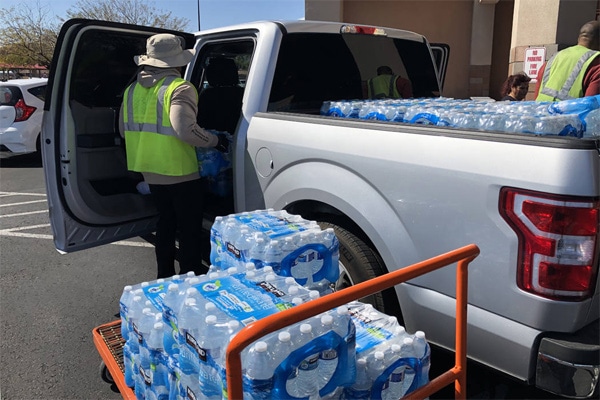
It is much smarter, safer and economical to stock up on water ahead of time. This article will go over how much water to store in your apartment, how to store water and some ideas for water conservation in emergency situations.
Storing Water in Apartments
The primary problem with storing water for emergencies in an apartment is that water is heavy and takes up a significant amount of room. People buying up cases of water would need roughly one case of bottles per person for every three days as a minimum. You can see how fast that would stack up if you wanted to prepare for an extended disruption in your water supply.
Don’t Buy Bottled Water For Emergencies
I’ll be honest, I want to slap everyone I see buying loads of bottled water for emergencies. Here is my list of reasons to not use bottled water for emergencies.
- Single-use bottles are wasteful – One use and they get thrown away, not so great for the environment.
- Disposable water bottles leach chemicals – Maybe you don’t care in an emergency, but still, why risk it?
- They aren’t convenient – Sure you can drink out of them, but try and move them around once they are out of their case or fill a pot for cooking
- They take up too much space – Cases of small bottles take up lots of extra space in comparison to a jug.
- Disposable bottles are expensive – The water out of your tap costs you nearly nothing. Bottled water is literally tap water put in bottles
How Much Water For Emergencies
The general rule for water during emergency situations is one gallon per person per day. Most emergency organizations suggest having at least 3 days of water stored up in case of emergencies. These are of course just general guidelines and can easily double in warm climates or if there are additional water needs due to health issues.
Personally I think that is a good static amount of water to have on hand, but in the event of things going really sideways, you should be prepared for at least a week and have a plan for at least two weeks with no water service.
Gallons of Water To Store Per Person
| 3 Days | 1 Week | 2 Weeks | |
| 1 Person | 3-6 Gallons | 7-14 Gallons | 14-28 Gallons |
| 2 People | 6-12 Gallons | 14-28 Gallons | 28-56 Gallons |
| 4 People | 12-24 Gallons | 28-56 Gallons | 56-112 Gallons |
| 6 People | 18-36 Gallons | 42-84 Gallons | 84-168 Gallons |
As you can see, stocking up enough water for a large family for an extended period of time, particularly in a warm climate can be a real challenge, particularly in an apartment with restricted storage space.
Containers For Storing Water
What to store your emergency water supply in is probably the second biggest question when you are setting up your emergency supplies. Here are some tips on what not to store water in, some cheap solutions for storing water and some more long term water storage options.
What Not To Store Water In
Some basic things not to store water in are:
- Plastic Milk Jugs – The protein is hard to remove and they aren’t durable
- Bleach or other chemical bottles – It is nearly impossible to remove all the contaminants
- Glass Containers – While they are easy to clean, they are fragile and heavy
- Paper boxes/containers – Again, not durable and impossible to fully clean
Improvised Water Storage
If you are improvising your emergency water storage, your best bet is 2 liter soda bottles. They are readily available, tough and you can clean them. Following the FEMA suggestions, wash them with dish soap, rinse thoroughly and then sanitize with 1 teaspoon of non-scented liquid household chlorine bleach to a quart (1/4 gallon) of water.
Just swish that mixture around in the container and rinse the lid and you are ready to go. Alternatively, you can use a commercial bottle disinfectant like Iodophor Sanitizer.
Once this is done, fill your bottles with water. If you using city water, it is already treated with chlorine and you can directly fill your containers. If it hasn’t been treated, add 2 drops of non-scented chlorine bleach to each bottle before sealing.
Hard Containers for Water
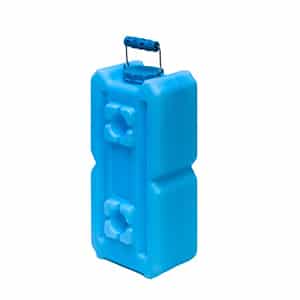
My choice for permanent water storage containers are hard plastic containers that can be stacked or tucked into small spaces. My go-to container is a Reliance 5-gallon container, but they come in a variety of sizes to fit your needs. 5 gallons for me is fine as I’m a big guy and don’t have an issue moving it around.
These are great for stashing in the back of a closet, and 3 of them in a closet will hold 21 gallons of water, and will likely be enough water for a couple for a week.
The other option is to get water containers that you can stash underneath your bed. While not cheap, WaterBrick makes 3.5gallon containers that are only 6″ high which should fit under most beds.
Regardless of which ones you choose, look for their ability to stack, durability and that they are rated for drinking water. Be sure that they are of a size you can manage and will be useful to you.
One thing to avoid is the clear plastic containers. My experience is that they are far too thin and brittle to be a good solution for long term water storage.
Soft Containers for Emergency Water
For a long-term emergency water supply, I stick to hard plastic containers. For a more short term solution, I highly suggest having some soft water storage options. The classic option is the old school soft plastic 5-gallon camping jug that has been around for decades.
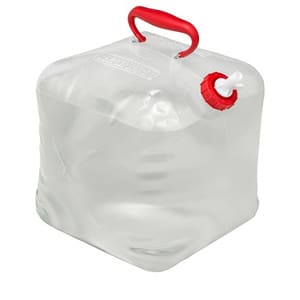
The advantage here is that when you need to prepare for something, you can fill up 4-6 of these and be ready to be out of water for a week or more. There are of course a variety of styles for these that you may want to check out. The old-school plastic jugs work, but you may want to check out some of the new fabric water jugs as well.
Emergency Water Storage Strategy
Because you have limited space in an apartment, it is difficult to store a huge amount of water for emergencies. My suggestion is to balance your on-hand emergency supply of water, with a flexible supply of water. For example, I usually have my 7-gallon jug of water filled up and ready for whatever. If there is an earthquake, I know I have that water as backup. This is where hard plastic emergency containers factor into my emergency planning.
Now if I lived somewhere where there were occasional events that might shut down the water for a week or more, like in Florida, I would have enough soft containers to stack up two weeks worth around my apartment. That is where the soft emergency water containers come into my plan. If I knew there was a hurricane or other storm coming for example, I would fill them up and be ready. Once the danger passed, I could empty them out and put them away for next time.
If you think you will need to be needing more water than you can store, then you need to really start thinking about alternate sources of water and how you will prepare or filter it. I live in the PNW, for much of the year, water is not an issue, it is raining or snowing all the time so this isn’t a concern for me. If you don’t have that advantage, consider where you can source water long term, and how you can filter and sanitize it.
Minimizing Water Use
An important consideration for storing water in a SHTF situation is minimizing the amount of water you use. Obviously you need a portion of your water for drinking every day. Never skimp on that!
The biggest place we waste water is using the toilet. If the water is out, you won’t have the luxury of flushing gallons of water down the drain with every flush. Have a solution for dealing with the inevitable human waste that is clean and doesn’t require water. My suggestion is to use the 5-gallon bucket liners and a 5 gallon bucket lid. They aren’t expensive, easy to store and will take care of waste if things go to hell.
Just in general cleaning and cooking, if you are cautious and mindful of your water usage, you can extend your supplies significantly.
Extending Your Emergency Water Supplies
The easiest way to extend your water supplies is to use what you can find around you. The issue with that is that if things are going badly in the world, that may mean that you are obtaining water from less than ideal sources and they might be contaminated. Even your tap water in some locations can be highly suspect even during good times.
To solve this problem, you should have a high-quality water filter that removes viruses, which is not common for most filters. I suggest the Epic Pure Water Filter, primarily because it filters out the majority of the lead and fluoride that is found in most city water, as well as contaminants like pharmaceuticals (which are in most city water).
A filter like this is good for everyday use, and for use when your city water is compromised, or you are having to use surface water or rainwater.
Final Thoughts On Storing Water In Apartments
Prepping for emergencies is always a challenge in apartments, but it isn’t impossible. For a small family, it is completely possible to stock up enough food and water to survive even a full month without water, power, and heat in an apartment. It may not be a comfortable time, but it is survivable.
What it takes is thinking ahead and being ready for situations before they hit. I’m writing this right now as the world is dealing with the COVID-19 pandemic. I’m seeing entire stores wiped out of water, toilet paper, medical supplies, and even food to a large extent. If you are hearing that there is a crisis, it is likely already too late.
Plan ahead, get yourself minimally prepared and you won’t be one of the crazies at Costco fighting someone for a case of water and a 128 pack of toilet paper!
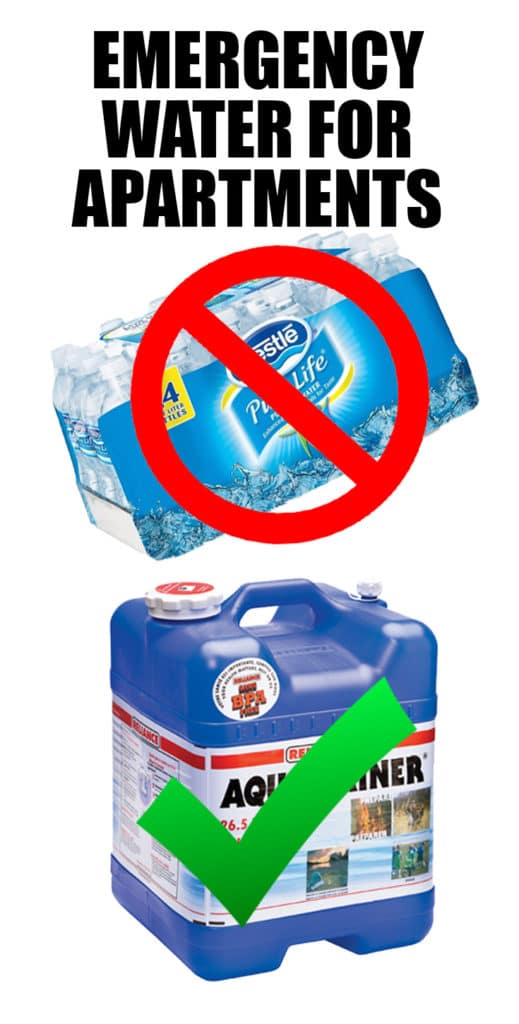
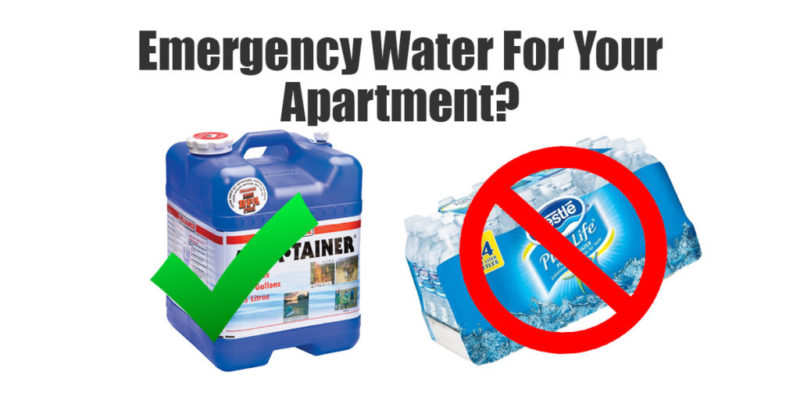
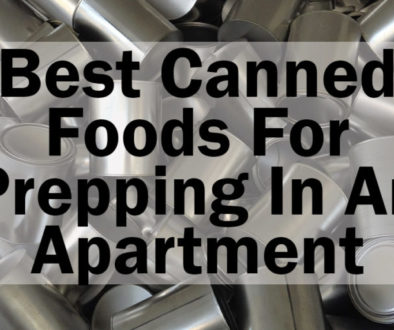
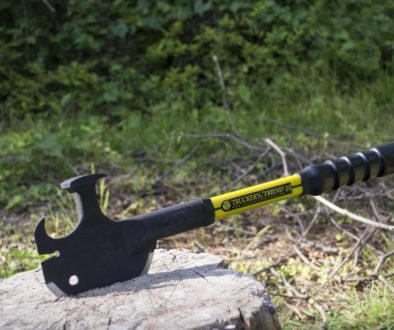
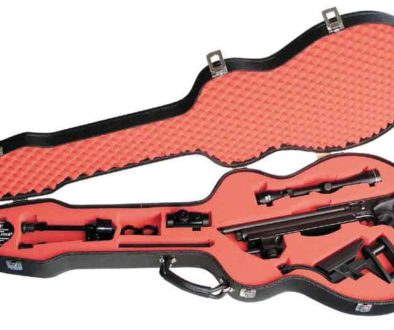
Best Canned Foods For Prepping In An Apartment - MadMadViking
March 27, 2020 @ 4:12 am
[…] Don’t Forget Water In Your Prepping Plans! […]
Hacks to make camping with the family easier and more fun
June 21, 2020 @ 2:53 am
[…] water containers think you should have a few around no matter what as I wrote in this article on storing water in your apartment for in case things go really sideways in the […]
Awesome camping gadgets and presents for 2021
August 5, 2021 @ 3:04 am
[…] I love this rocket stove because it not only is really useful for camping but makes for a great emergency stove for cooking in case the power has gone out at home. With this sort of stove you can still cook your food even if you live in an apartment and just have a small balcony to work with. Perfect for prepping if you live in an apartment. […]